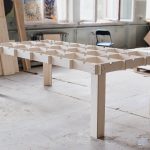Formerly HTL-Steig, since April 2018 Otk Klettersteig. In combination with the via ferrata Blutspur (D/E) (KLIK), it is the most difficult via ferrata in Vienna. Otk Klettersteig was built in 1998 by Hans Müller and HTL students. In 2011, it was taken over by the OTKs, from Weiner Neustadt. (Austrian Tourist Club). In 2018 it was renovated and put into service. We passed it in May 2018 ?
Difficulty: D/E
Passage time: 2 hours
Approach: 15 minutes
Descent: 45 minutes
Topo: CLICK
Starting point: parking under Hohe Wand, signs are visible, details can be found at
Nearby accommodation: Camping Hohe Wand Blick
Via ferrata is intended for very experienced mountain tourists, people with experience in via ferrata, familiar with the exposition and having very good condition and power reserve. Those who like the barrel will be satisfied.
Via ferrata OTK KLettersteig makes very good use of the terrain, the difficulties are visible from the very entrance and there is not much space and time for rest here. You have to press upwards or you have to make a “plug”. Via ferrata Otk Klettersteig is divided into 3 longer stages, consisting of several short sections with different valuations of difficulties.
How does Via ferrata Otk Klettersteig work?
The approach from the car park only takes a few minutes, so you can go completely light. We start under the hover on relatively good steps diagonally to the left and up. After passing the hanger we move vertically upwards with the system of scratches and jams. There is no time to think about it, so we shutter after difficulties using additional buckles up to the key point behind D/E, which literally devours our energy. We have air under our feet from the very beginning.
Continue with the pillar upwards along the buckles until you reach the traverse to the left. From there we have two options to choose from – both with difficulties after D. We chose the left variant, with fewer artificial facilities. Immediately after this episode we go out with a plate to a place where we can gain strength and enter into the book of passages.
Here you pass the climbers on the Neuer Innerkoflersteig road (for 5) and go up the hill. We start with the difficulties – the exit is a fireplace where you have to put yourself in a good position. Then, a piece of easy land to another tile behind D. We go to uninsured terrain and move on to another easier part of the ferrata.
We go to the place where we can make another rest before the upcoming difficulties and enjoy the views. This is where the landscape emerges from the Hohe Wand peak. You can see paragliders, climbers on nearby roads and tourists to Skywalk and a beautiful mountain scenery.
The third stage of Via ferraty Otk Klettersteig begins with a sightseeing approach to the traverse behind the C.
Here climbing technology is again useful. It is necessary to stand well on the steps or on the so-called friction to move on via ferrata to the right.
At the end of the traverse, a jerk is waiting for us to pass to the rest of the ferrata. It is a real challenge.
The engraving ends with the exit after D and the ferrata turns 180 degrees. The tip does not allow us to slow down the pace.
Follow the pavement behind D to overcome the difficulties and cross the last metres via ferrata a little easier terrain until you get to Hohe Wand.
And there you only have to lie down, stretch, shoot and admire the landscapes.
As the sink was approaching, we quickly removed the equipment, packed it and almost ran down to the car park.
Read the rest of the reports from the via ferrat:
Via ferrata Hans von Heidsteig, Preinerwand, Austria
Via ferrata Gebirgsverainssteig, Hohe Wand, Austria
Via ferrata Währingersteig, Hohe Wand, Austria
Via ferrata Blutspur (output variant for OTK Klettersteig)
Sentiero dei Contrabbandieri, Lake Garda, Italy
Via ferrata Monte Albano (Ottorino Marangoni), Lake Garda, Mori, Italy
Via ferrata OTK via ferrata to Hohe Wand











